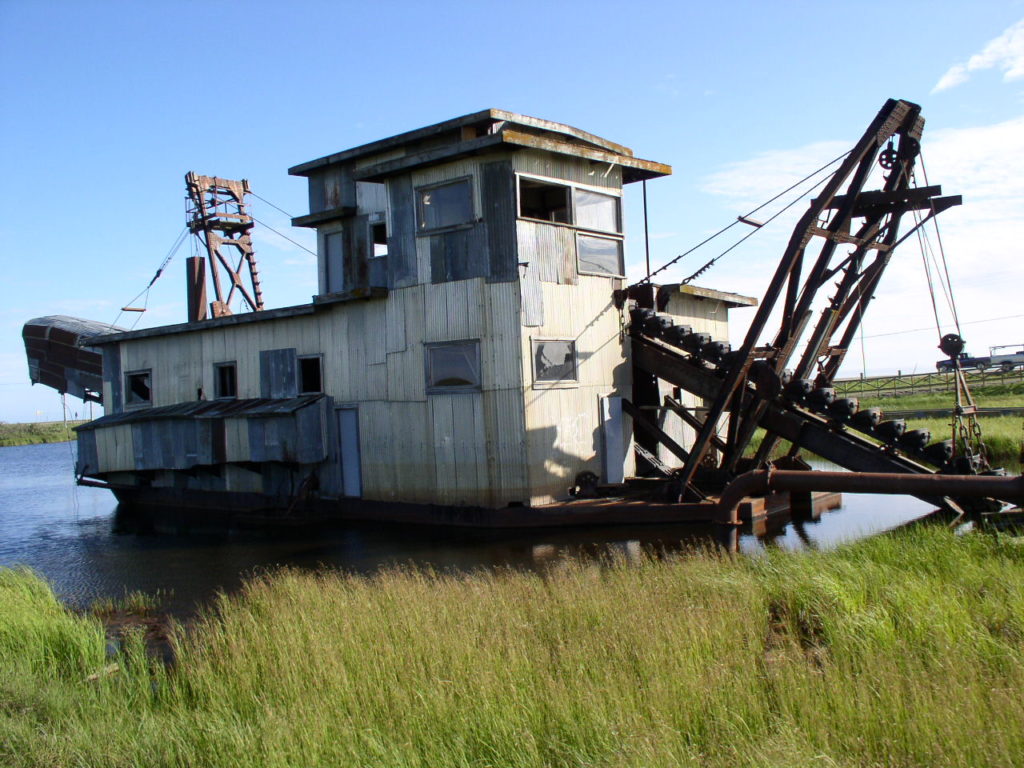Klondike Gold Rush
The Klondike Gold Rush tells the legendary story of the Alaska-Yukon Gold Rush. Over 100,000 people voyage to the far North intent on reaching the Canadian boom-town Dawson City and striking it rich.
Historians and authors bring insight and perspective to the event that changed the lives of thousands. Present-day characters reveal that the frontier spirit is still alive in the Klondike.
Klondike Gold Rush

vintage Alaska gold dredge in Nome
From Wikipedia, the free encyclopedia:
The Klondike Gold Rush was a migration by an estimated 100,000 prospectors to the Klondike region of Yukon, in north-western Canada, between 1896 and 1899. Gold was discovered there by local miners on August 16, 1896; when news reached Seattle and San Francisco the following year, it triggered a stampede of prospectors. Some became wealthy, but the majority went in vain. It has been immortalized in films, literature, and photographs.
To reach the gold fields, most prospectors took the route through the ports of Dyea and Skagway, in Southeast Alaska. Here, the “Klondikers” could follow either the Chilkoot or the White Pass trails to the Yukon River, and sail down to the Klondike. The Canadian authorities required each of them to bring a year’s supply of food, in order to prevent starvation. In all, the Klondikers’ equipment weighed close to a ton, which most carried themselves, in stages. Performing this task, and contending with the mountainous terrain and cold climate, meant those who persisted did not arrive until summer 1898. Once there, they found few opportunities, and many left disappointed.
To accommodate the prospectors, boom towns sprang up along the routes. At their terminus, Dawson City was founded at the confluence of the Klondike and Yukon rivers. From a population of 500 in 1896, the town grew to house approximately 30,000 people by summer 1898. Built of wood, isolated, and unsanitary, Dawson suffered from fires, high prices, and epidemics. Despite this, the wealthiest prospectors spent extravagantly, gambling and drinking in the saloons. The Native Hän people, on the other hand, suffered from the rush; they were forcibly moved into a reserve to make way for the Klondikers, and many died.
Beginning in 1898, the newspapers that had encouraged so many to travel to the Klondike lost interest in it. In the summer of 1899, gold was discovered around Nome in west Alaska, and many prospectors left the Klondike for the new goldfields, marking the end of the Klondike Rush. The boom towns declined, and the population of Dawson City fell. Gold mining production in the Klondike peaked in 1903 after heavier equipment was brought in. Since then, the Klondike has been mined on and off, and today the legacy draws tourists to the region and contributes to its prosperity.
During the gold rush, transport improvements meant that heavier mining equipment could be brought in and larger, more modern mines established in the Klondike, revolutionising the gold industry. Gold production increased until 1903 as a result of the dredging and hydraulic mining but then declined; by 2005, approximately 1,250,000 pounds (570,000 kg) had been recovered from the Klondike area. In the 21st century Dawson City still has a small gold mining industry, which together with tourism, drawing on the legacy of the gold rush, plays a role in the local economy. Many buildings in the center of the town reflect the style of the era. The Klondike River valley was affected by the gold rush by the heavy g that occurred after it.
Klondike Gold Rush
#######
Be sure to view our Gold nuggets for sale.
View our Natural Silver specimens
Also see the most expensive type of gold nuggets, the Crystalline Gold Nuggets
Subscribe to our Youtube Arizona Gold Prospecting channel
1 Comment
San Diego personal injury lawyers · April 27, 2022 at 11:00 am
Enjoyed the read